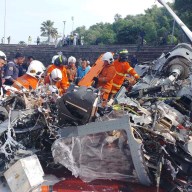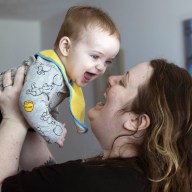 Are New York City’s subways getting dirtier? A Straphangers Campaign survey says yes.
Are New York City’s subways getting dirtier? A Straphangers Campaign survey says yes.
Credit: Getty Images
New Yorkers noticing more “subway schmutz” aren’t alone.
The number of clean subway cars decreased from 52 percent in 2011 to 42 percent in 2013, according to the Straphangers Campaign’s annual “schmutz” survey released Thursday.
“We’re looking at the grime, the spills, the food,” Jason Chin-Fatt, the campaign’s field organizer. “You know, seats people avoid because of sticky spots.”
The campaign said the decline represents a trend of decreasing cleanliness on subway cars. The same survey rated 56 percent of cars clean in 2008.
Chin-Fatt said a surge in subway riders in the last few years could be making the subways harder to keep clean.
“When ridership goes up, there’s more opportunities for people to spill coffee and food,” he said.
The campaign’s survey found a wide disparity among the system’s 20 lines. Cars on the D line were the dirtiest, with just 17 percent clean, and L trains were the cleanest at 63 percent. Nine subway lines were found to have experienced “significant detonation” in the last two years.
The cars were rated for cleanliness of floors and seats using the Metropolitan Transportation Authority’s own guidelines.Subway cars were found clean if they were “basically dirt free” or had “occasional ‘ground-in’ spots, but generally clean.” The survey did not rate litter.
In responding to the findings, New York City Transit spokesman Kevin Ortiz said that the fleet of roughly 6,200 subway cars are cleaned regularly at terminals and undergo a thorough cleaning while in yards.
“During the course of a round trip, customers can accidentally drop drinks, come in with muddy shoes or slush and salt during a snowstorm, but that is not indicative of our car cleaning efforts,” Ortiz said.
The MTA conducts its own subway car cleanliness survey. In the second half of 2013, the transit authority found 92 percent of subway cars in service were clean. At the same time, the authority survey deemed 98 percent of subway cars at terminals were clean.
The Straphangers Campaign campaign acknowledged the contradicting results but did not point to factors that would cause the inconsistency.
Ortiz said the discrepancy is the result of differing methodology. A traffic team surveys 250 cars for every subway line during a six-month period. The Straphangers Campaign, by comparison, surveyed 100 cars on each of the 20 lines during a three-month period.
The transit authority also surveys cars both in-service and at terminals to better evaluate cleaners.
“By conducting these surveys on subway cars in service, the Straphangers lessen the overall impact of our car cleaners at terminals. We simply disagree with the straphangers flawed methodology,” Oritz said.
A 2013 MTA passenger satisfaction survey found 74 percent of riders were satisfied or very satisfied with the overall cleanliness of subway cars. Riders were nearly equally satisfied with the cleanliness of floors and seats on subways.
Still, Chin-Fatt said that riders the campaign has spoken confirmed the new survey.
“Who are you going to trust, New York City Transit or your own eyes?” he said.
The Straphangers Campaign Best to Worst: Cleanliness by Subway Line
- L Train, 63 percent
- J Train, 56 percent
- 7 Train, 55 percent
- E Train and G Train, 52 percent
- M Train, 48 percent
- 6 Train, 47 percent
- 4 Train, 46 percent
- 3 Train, 45 percent
- 1 Train, 44 percent
- B Train, 40 percent
- Q Train, 39 percent
- 5 Train, 38 percent
- N Train, 37 percent
- R train, 36 percent
- C Train and F Train, 31 percent
- 2 Train, 29 percent
- A Train, 26 percent
- D Train, 17 percent
Follow Anna Sanders on Twitter @AnnaESanders
















